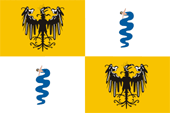Lombardei |
|
|
|
| Übersicht – Contents: | |
Lombardei |
|
|
|
| Übersicht – Contents: | |
Flagge – Flag: |
|
 |
Flagge der Lombardei – flag of the Lombardy, Seitenverhältnis – ratio = 2:3, Quelle/Source: nach/by: Wikipedia (D) |
historische Flaggen – historical Flags: |
|
 |
1277–1397, Flagge der Lombardei – flag of Lombardy, Quelle/Source: nach/by: World Statesmen |
 |
1397–1765, Flagge Herzogtum Mailand – flag of Duchy of Milan, Quelle/Source: nach/by: World Statesmen |
 |
1815–1866, Königreich Lombardo-Venetien – Kingdom of Lombardy-Venetia, Staatsflagge – state flag, Quelle/Source: markodehaeck.free.fr |
Bedeutung/Ursprung der Flagge – Meaning/Origin of the Flag: |
|
| Die Flagge der Lombardei ist einfarbig grün und zeigt in der Mitte das Logo der Region. Dieses sieht aus wie ein Kreuz, ist jedoch die so genannte "Rosa Camuna". Sie soll an die prähistorischen Zeichnungen in Camuni erinnern. | The flag of Lombardy is single-coloured green and shows in the middle the emblem of the region. This looks like a cross, however, it is the so-called "Rose of Camuna". It should remember the prehistoric drawings in Camuni. |
| Die historische Heraldik der Lombardei, die sich auch auf den Flaggen wiederfand, ist die Heraldik des Herzogtums Mailand unter der Dynastie der Visconti, ab dem Ende des 14. Jahrhunderts vermischt mit der Heraldik des Deutschen Reiches. Das Wappen der Visconti zeigte einen Lindwurm, der einen Menschen ausspeit (gebirt). | The
historical heraldry of Lombardy, which was to found itself on the flags, is
the heraldry of the Duchy of Milan under the dynasty of Visconti. From the end of the 14th century it was mixed with the heraldry of the German Empire. The coat of arms of the Visconti showed a dragon that spits out a man (bears a man). |
| Die Flagge des Königreichs Lombardo-Venetien ist nicht sicher überliefert. Wahrscheinlich wurde eine schwarz-goldene Flagge verwendet, so wie sie auch vom Kaiserreich Österreich als Nationalflagge verwendet wurde. | The flag
of the Kingdom of Lombardy-Venetia is not handed
down safely. Probably a black-golden flag was used, as it was used by the Empire of Austria as the national flag. |
| Quelle/Source: Wikipedia (D), Volker Preuß | |
Landkarte der
Regionen Italiens – Map of the Regions of Italy: |
|
| Landkarte/Map: Volker Preuß |
Zahlen und Fakten – Numbers and Facts: |
|
|
|
|
|
|
|
|
|
|
|
|
|
|
|
|
Geschichte: |
|
Antike
· in der heutigen Lombardei siedeln Räter, Umbrer und Kelten ab 5. Jhd. v.Chr. · Einwanderung von Etruskern aus den Alpen ab 225 v.Chr. · römische Eroberung, Errichtung der Provinz Gallia cisalpina 89 v.Chr. · die Provinz Gallia cisalpina wird der Provinz Italien angegliedert 452 · Hunneneinfälle 476 · Absetzung des letzten römischen Kaisers Romulus Augustulus, Ende des (West)Römischen Reiches, die heutige Lombardei gehört bis 493 zum Reich des Odoaker 535 · Eroberung durch Byzanz (Ostrom) 489 · Eroberung des Gebiets durch die Ostgoten 568/569 · Eroberung und Besiedlung durch die Langobarden (daher: Lombardei) 572 · Pavia wird Hauptstadt des Langobardenreiches 774 · Eroberung durch die Franken 781 · Eingliederung der Lombardei in das Frankenreich der Karolinger 843 · bei der Teilung des Frankenreiches kommt die Lombardei zum Königreich Italien 888 · Nach dem Aussterben der Karolinger zerfällt die Region in Kleinstaaten 961 · Otto I. bringt die Lombardei an das Deutsche Königreich ca. 1000 · Mailand tritt dem Lombardischen Bund gegen den deutschen Kaiser bei (Mailand, Bergamo, Lecco, Cremona, Mantua und Brescia) 1167 · der Lombardische Bund stellt sich gegen sich gegen den deutschen Kaiser Friedrich I. (Barbarossa) 1183 · Anerkennung der Unabhängigkeit des Lombardischen Bundes ca. 1215–1350 · Kämpfe zwischen Ghibellinen (Kaiserpartei) und Guelfen (Papstpartei) 1277 · Ottone Visconti übernimmt die Macht in Mailand, später beherrscht die Familie von Mailand aus die gesamte Lombardei 1328 · die Familie Gonzaga übernimmt die Macht in Mantua (später Herzogtum Mantua, 1708 habsburgisch 1395 · Gian Galeazzo Visconti erhält vom Deutschen König Wenzel von Luxemburg den Titel Herzog von Mailand 1450 · die Visconti sterben aus, die Familie Sforza übernimmt das Herzogtum Mailand 1499 · Frankreich interveniert in Norditalien, das Herzogtum Mailand wird französischer Besitz 1512 · Parma wird durch den Papst als Herzogtum vom Herzogtum Mailand abgetrennt 1525 · Kaiser Karl V. besiegt bei Pavia die französischen Interventen 1535 · das Herzogtum Mailand wird einem Spanisch-Habsburgischen Statthalter unterstellt 1701–1714 · Spanischer Erbfolgekrieg 1714 · Friedensvertrag von Utrecht, das Herzogtum Mailand wird Österreichisch-Habsburgischer Besitz 1797 · nach der Eroberung durch französische Truppen wird das Herzogtum Mailand aufgelöst und napolèonischen Satellitenstaaten zugeordnet 1815 · Wiener Kongress, Österreich erwirbt Venetien und die Lombardei (Königreich Lombardo-Venetien) 1859 · Österreichisch-Französischer Krieg, nach den Schlachten von Solferino und Magenta muss Österreich die Lombardei einschließlich Bergamo und Brescia an Frankreich abtreten 1860 · Frankreich tauscht die Lombardei gegen Savoyen und die Grafschaft Nizza mit Sardinien-Piemont, die Lombardei wird so Teil von Sardinien-Piemont und somit des 1861 durch das Haus Savoyen (die Herrscherdynastie von Sardinien-Piemont) gegründeten Königreichs Italien 17.03.1861 · Krönung von Viktor Emanuel II. von Sardinien-Piemont zum König des Königreichs Italien 1946 · Gründung der Region Lombardei als Verwaltungseinheit |
History: |
|
antiquity
· in the today's Lombardy settle Raetians, Umbrians and Celts since 5th cent. B.C. · immigration of Etruscians from the Alpes since 225 B.C. · Roman conquest, establishment of the Province of Gallia Cisalpina 89 B.C. · the Province of Gallia Cisalpina gets incorporated into the Province of Italy 452 · Hun's invasions 476 · dismissal of the last Roman emperor Romulus Augustulus, end of the (West)Roman Empire, the today's Lombardy belongs until 493 to the Empire of the Odoaker 489 · conquest of the region by the Eastern Goth 568/569 · conquest and settlement by the Langobardes (from there: Lombardy) 572 · Pavia gets the capital of the Langobardian Empire 774 · conquest by the Franks 781 · incorporation of the Lombardy into the Frankish Empire of the Carolingians 843 · at the division of the Frankish Empire comes the Lombardy to the Kingdom of Italy 888 · after the vanish of the Carolingians disintegrates the Region into small states 961 · Otto I. brings the Lombardy to the German Kingdom ca. 1000 · Milano joines the Lombardian Alliance against the German Emperor (Milano, Bergamo, Lecco, Cremona, Mantua and Brescia) 1167 · the Lombardian Alliance takes position against the German Emperor Frederick I. (Barbarossa) 1183 · recognition of the independence of the Lombardian Alliance ca. 1215–1350 · fights between Ghibellines (emperor's party) and the Guelfes (pope's party) 1277 · Ottone Visconti takes over the power in Milano, later rules the family from Milano the whole Lombardy 1328 · the family Gonzaga takes over the power in Mantua (later Duchy of Mantua, 1708 to the House of Habsburg 1395 · Gian Galeazzo Visconti receives from the German King Wenceslaus of Luxembourg the title of the Duke of Milan 1450 · extinction of the Visconti family, the family Sforza takes over the Duchy of Milan 1499 · France intervenes in Northern Italy, the Duchy of Milan becomes a French estate 1512 · Parma gets separated by the Pope as a duchy from the Duchy of Milan 1525 · Emperor Karl V. defeats the French interventors near Pavia 1535 · the Duchy of Milan gets subordinated under a Spanish-Habsburg proconsul 1701–1714 · Spanish heritage succession war 1714 · peace treaty of Utrecht, the Duchy of Milan becomes an Austrian-Habsburg estate 1797 · after the conquest by French troops the Duchy of Milan gets dissolved and incorporated into Napolèonic satellite states 1815 · Vienna Congress, Austria purchases Venice and the Lombardy (Kingdom of Lombardy-Venetia) 1859· Austro-French War, after the battles of Magenta and Solferino Austria has to cede Lombardy, including Bergamo and Brescia to France 1860 · France exchanges the Lombardy against Savoy and the County of Nice with Sardinia-Piedmont, Lombardy becomes in this way a part of Sardinia-Piedmont and thus a part of the in 1861 by the House of Savoy (the ruling dynasty of Sardinia-Piedmont) founded Kingdom of Italy 17th of March 1861 · coronation of Victor Emmanuel II. of Sardinia-Piedmont to the King of the Kingdom of Italy 1946 · establishment of the Lombardy region as administration unit |
| Quelle/Source: Atlas zur Geschichte, Wikipedia (D) |
Ursprung des Landesnamens – Origin of the Country's Name: |
|
| Der Name "Lombardei" geht auf die Langobarden zurück. Sie kamen ursprünglich aus dem heutigen Südschweden, siedelten später am Unterlauf der Elbe und kamen im 6. Jahrhundert nach Norditalien. Der Name der Langobarden wird häufig mit dem Begriff der "Langbärte" in Verbindung gebracht, und die Legenden scheinen das zu bestätigen, jedoch geht das Wort auf die "langen Barden", langstielige Streitäxte zurück. | The name "Lombardy" goes back to the Lombards. They came originally from the today's southern Sweden, settled later along the lower reaches of the Elbe river, and came in the 6th century to northern Italy. The name of the Lombards is often associated in connection with the idea of "long beards", and the legends seem to confirm this, however, the word goes back to the long-handled battle axes, called "long bards". |
| Quelle/Source: Handbuch der geographischen Namen | |